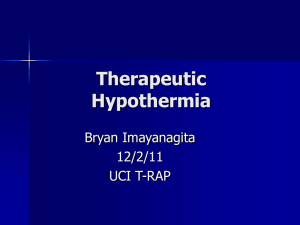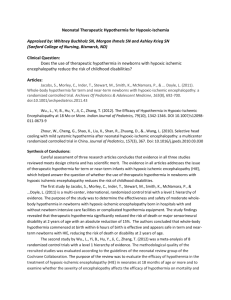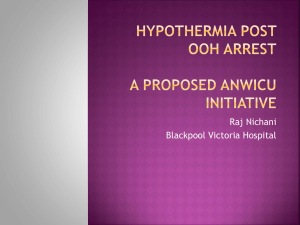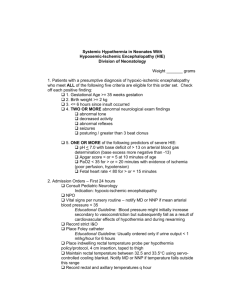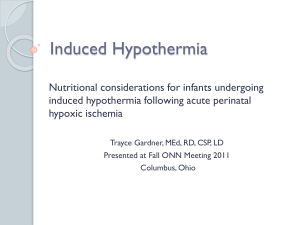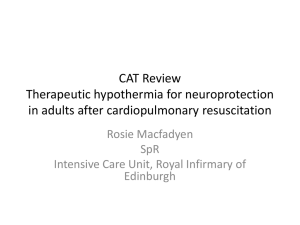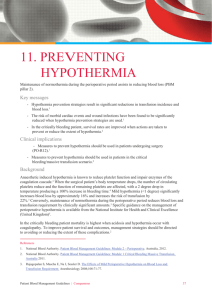Does the Use of Hypothermia Therapy Improve Outcomes for
advertisement
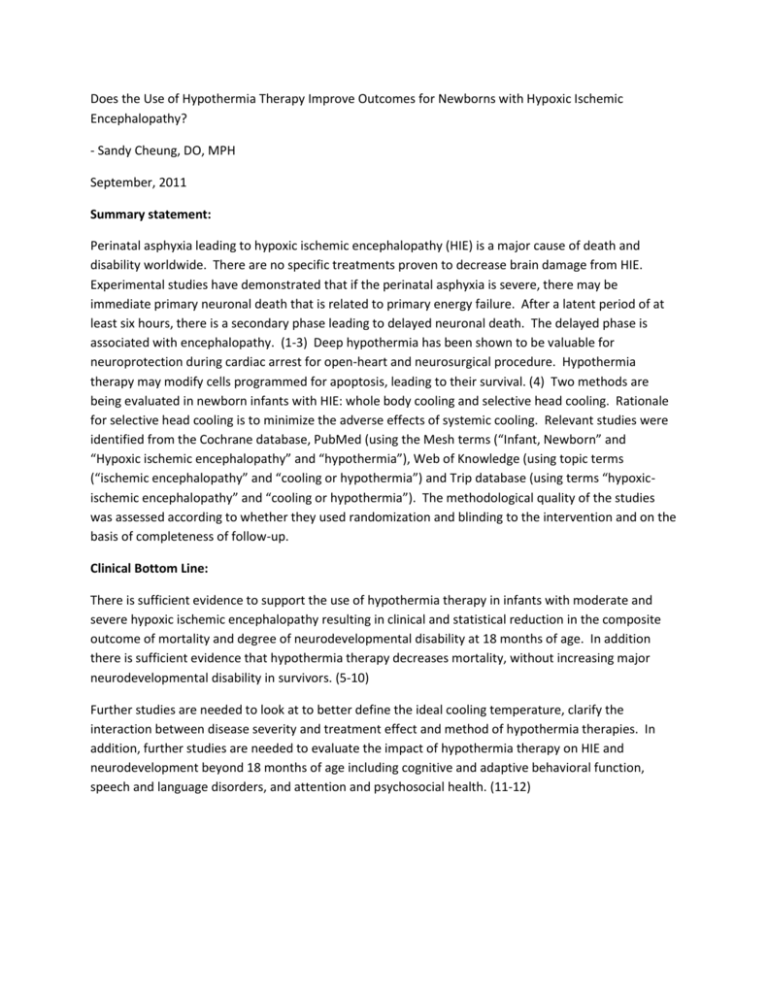
Does the Use of Hypothermia Therapy Improve Outcomes for Newborns with Hypoxic Ischemic Encephalopathy? - Sandy Cheung, DO, MPH September, 2011 Summary statement: Perinatal asphyxia leading to hypoxic ischemic encephalopathy (HIE) is a major cause of death and disability worldwide. There are no specific treatments proven to decrease brain damage from HIE. Experimental studies have demonstrated that if the perinatal asphyxia is severe, there may be immediate primary neuronal death that is related to primary energy failure. After a latent period of at least six hours, there is a secondary phase leading to delayed neuronal death. The delayed phase is associated with encephalopathy. (1-3) Deep hypothermia has been shown to be valuable for neuroprotection during cardiac arrest for open-heart and neurosurgical procedure. Hypothermia therapy may modify cells programmed for apoptosis, leading to their survival. (4) Two methods are being evaluated in newborn infants with HIE: whole body cooling and selective head cooling. Rationale for selective head cooling is to minimize the adverse effects of systemic cooling. Relevant studies were identified from the Cochrane database, PubMed (using the Mesh terms (“Infant, Newborn” and “Hypoxic ischemic encephalopathy” and “hypothermia”), Web of Knowledge (using topic terms (“ischemic encephalopathy” and “cooling or hypothermia”) and Trip database (using terms “hypoxicischemic encephalopathy” and “cooling or hypothermia”). The methodological quality of the studies was assessed according to whether they used randomization and blinding to the intervention and on the basis of completeness of follow-up. Clinical Bottom Line: There is sufficient evidence to support the use of hypothermia therapy in infants with moderate and severe hypoxic ischemic encephalopathy resulting in clinical and statistical reduction in the composite outcome of mortality and degree of neurodevelopmental disability at 18 months of age. In addition there is sufficient evidence that hypothermia therapy decreases mortality, without increasing major neurodevelopmental disability in survivors. (5-10) Further studies are needed to look at to better define the ideal cooling temperature, clarify the interaction between disease severity and treatment effect and method of hypothermia therapies. In addition, further studies are needed to evaluate the impact of hypothermia therapy on HIE and neurodevelopment beyond 18 months of age including cognitive and adaptive behavioral function, speech and language disorders, and attention and psychosocial health. (11-12) Summary of Studies Evaluated (5-10): Study Enrollment criteria Method Duration of cool N Time of Follow-up Results Notes Jacobs et al (2008) <6h pH <7.1, BE >12 Apgar <5 at 10’ Clinical enceph WBC, SHC >48 h 33.5-34.5°C rectal 8 RCT 327 (H) 330 (N) 18 mth Death or severe disability: RR 0.76*; NNT=7 Mortality: RR 0.74*; NNT=11 Severe neuromotor disability: RR 0.68* Adverse effects: Bradycardia, thrombocytopenia -Ongoing studies not included in meta-analysis <6 h pH <7.0, BE>16 Apgar <5 at 10’ Abnl aEEG WBC 72h 33-34°C rectal 163 (H) 162 (N) 18 to 21 mth Death or severe disability: 53% (N) vs 45% (H); NNT=13 Mortality: 27% (N) vs 26% (H); NNT=72 Survival without neuromotor disability: 28% (N) vs 44% (H)*; NNT=6 Multiple neurodevelopmental disabilities: 30% (N) vs 19% (H)*; NNT=9 Cerebral palsy: 41% (N) vs 28% (H)*; NNT=7 -Analyzed according to intention to treat -Neurodevelopmental assessments at 18 months may not reliably predict later outcomes <6h pH <7.0, BE>16 Apgar <5 at 10’ Abnl aEEG WBC 18 to 21 mth Death or severe disability: 83% (N) vs 51% (H)*; NNT=4 Severe neuromotor disability: 57% (N) vs 21% (H)*; NNT= 3 Disabling cerebral palsy: 48% (N) vs 13% (H)*; NNT = 4 -Analyzed using OR and did not use intention to treat -Large percentage of mortality -Neurodevelopmental assessments at 18 months may not reliably predict later outcomes <6 h pH<7.0, BE >12 Apgar <5 at 10’ Clinical enceph WBC 18 to 21 mth Death or severe disability: 66% (N) vs 52% (H)*; NNT=7 Mortality: 39% (N) vs 25% (H)*; NNT=7 Survival without neuromotor disability: 23% (N) vs 40% (H)*; NNT=7 Multiple neurodevelopmental disabilities: 42% (N) vs 35% (H); NNT=14 Cerebral palsy: 28% (N) vs 27% (H); NNT=4 -Analyzed not according to intention to treat -Neurodevelopmental assessments at 18 months may not reliably predict later outcomes Shankaran et al (2008) <6h pH<7.0, BE>16 Clinical enceph WBC 72h 33-33.5°C esophageal 102 (H) 106 (N) Acute outcome looking at adverse effects: Not statistically or clinically significant -Transient decreases in esophageal temperature to <32˚C Sarkar et al (2009) <6h pH <7.0, BE >16 Apgar <5 at 10’ Abnl aEEG or clinical enceph WBC vs SHC 72 h 34-35°C (esophageal in WBC group; rectal in SHC group) 28 (WBC) 31 (SHC) Acute outcome looking at adverse effects: Not statistically or clinically significant -Not randomized Cochrane Azzopadi et al (2009) TOBY Simbruner et al (2010) neo.nEURO Jacobs et al (2011) LTF: 1 (H) 1 (N) 72 h 33-34°C rectal 62 (H) 63 (N) LTF: 9 (H) 5 (N) 72h 33-34°C rectal 110 (H) 111 (N) LTF: 3 (H) 10 (N) 4, 8, 12, 24, 48, 72 hours REFERENCES 1. Williams CE, Gunn A, Gluckman PD. Time course of intracellular ischemia in sheep. Stroke 1991;22:516-21. 2. Inder TE, Volpe J. Mechanisms of perinatal brain injury. Seminars in Neonatology 2000;5:3-16. 3. Sarnat HB, Sarnat MS. Neonatal encephalopathy following fetal distress: A clinical and electroencphalographic study. Archives of Neur 1976;33:696-705. 4. Edwards AD, Yue X, Squier MV, et al. Specific inhibition of apoptosis after cerebral hypoxic-ischemia by moderate post-insult hypothermia. Biochemical and Biophysical research communications 1995; 217:1193-9. 5. James SE, Hunt R, Tarnow-Mordi WO, et al. Cooling for newborns with hypoxic ischaemic encephalopathy (Review). Cochrane Database Syst Rev 2008:CD003311. 6. Azzopadi DV, Strohm B, Edwards AD, et al. Moderate hypothermia to treat perinatal asphyxial encephalopathy. N Engl J Med 2009;361:1349-58. 7. Jacobs SE, Morley CJ, Inder TE, et al. Whole-body hypothermia for term and near-term newborns with hypoxicischemic encephalopathy. Arch Pediatr Adolesc Med 2011;165(8):692-700. 8. Simbruner G, Mittal RA, Rohlmann F, et al. Systemic hypothermia after neonatal encephalopathy: outcomes of neo.nEURO.network RCT. Pediatrics 2010;126:e771-8. 9. Shankaran S, Pappas A, Laptook AR, et al. Outcomes of safety and effectiveness in a multicenter randomized, controlled trial of whole-body hypothermia for neonatal hypoxic-ischemic encephalopathy. Pediatrics 2008;122:e791-8. 10. Sarkar S, Barks JD, Bhagat I, et al. Effects of therapeutic hypothermia on multiorgan dysfunction in asphyxiated newborns: whole-body cooling versus selective head cooling. Journal of Perinatology. 2009;29:558-63. 11. Odd DE, Whitelaw A, Gunnell D, et al. The association between birth condition and neuropsychological functioning and educational attainment at school age: a cohort study. Arch Dis Child 2011;96:30-7. 12. Robertson CMT, Perlman M. Follow-up of the term infant after hypoxic-ischemic encephalopathy. Paediatr Child Health 2006;11(5):278-82.
